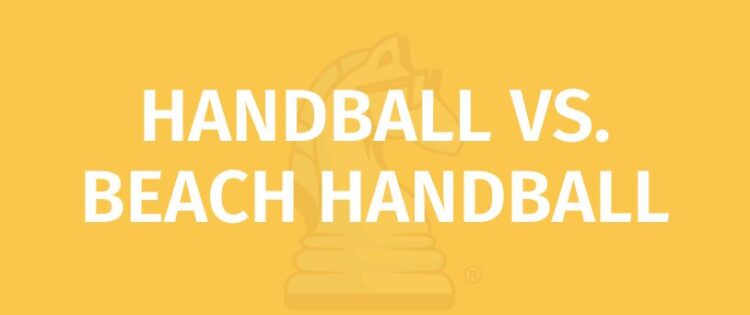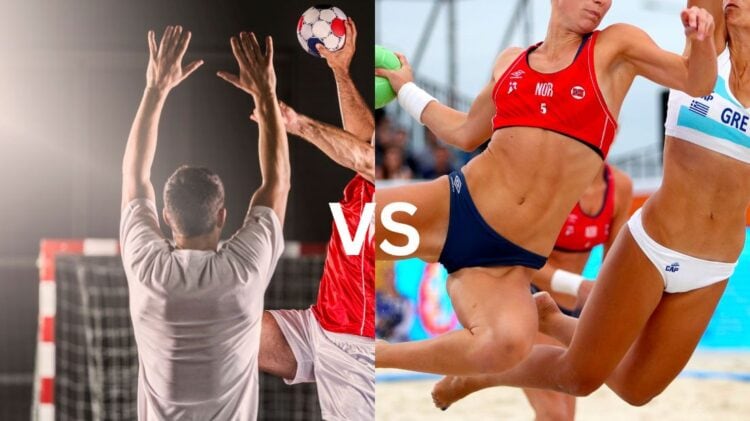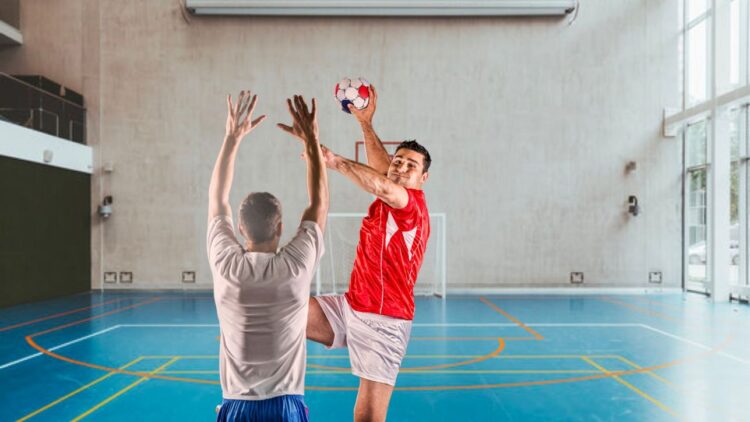
Handball enthusiasts are no strangers to the thrill and intensity of this fast-paced sport. From indoor arenas to sandy shores, handball has evolved to embrace different settings, giving rise to two distinct but equally captivating variations: handball and beach handball. Of course, while both sports share many similarities, they are also separate sports. Specifically, the playing surface creates unique differences in gameplay.
In this article, we will explore the similarities and differences between handball and beach handball.
SIMILARITIES

Similar to other sports that have beach equivalents, such as volleyball, both handball and beach handball are fundamentally the same sport. They share similarities that include:
1) Goals are scored by throwing a ball into the opponent’s net.
Goals are scored in both sports when a player throws the ball past the opponent’s goalie and into the net.
2) Ballhandlers cannot take more than three steps with the ball.
Both sports enforce a traveling rule that only allows players to take three steps with the ball before having to dribble or pass. However, due to the sand court in beach handballl, dribbles are essentially nonexistent.
3) Both sports use the same equipment.
The only equipment needed to play either version of handball is a ball and two goals.
4) No players other than the goalkeeper can cross the shooting line.
Both sports feature a shooting line/arc surrounding each team’s net. No player other than the goalie is allowed to enter this zone on their respective side of the court.
DIFFERENCES

While handball and beach handball share an extensive amount of similarities and have essentially the same fundamental rules, there are a few key differences that separate them.
COURT SPECIFICATIONS
Many of the differences between indoor handball and beach handball result from the different courts both games are played on.
Indoor handball matches are often played on solid hardwood floors. These courts measure 40 by 20 meters (about 131 by 67 feet) in length and width, respectively.
Beach handball matches are played on sand courts that are much smaller, measuring 27 by 12 meters (about 89 by 39 feet) in length and width, respectively.
TEAM SIZE AND POSITIONS
Indoor handball teams consist of seven players. Each player has a position, although they all participate in offensive and defensive possessions. In fact, even the goalkeeper is allowed to participate in offense, although they must follow the same rules as all other players once they cross the shooting arc.
Beach handball teams also have seven players, including one goalie, but only four are on the court at any time. The remaining three players can jump in and substitute at any point throughout the game. To put it more simply, each team has a set of three offensive players and a set of three defenders who freely swap out with each other whenever appropriate. Like indoor handball, goalies are still allowed to participate in their team’s offensive possessions.
MATCH FORMAT
Indoor handball matches consist of two 30-minute halves. In the event of a tie after the conclusion of the second half, two 5-minute overtime periods ensue. If this still isn’t enough time to decide on a winner, both teams take turns in one-on-one matchups against each other’s goalkeeper in a best-of-five shootout. Extra rounds are added to the shootout if necessary.
Beach handball matches consist of two 10-minute sets, with the score resetting between each. A team must win the two sets to win the match. In the event that both teams take a set, a best-of-five shootout occurs, with extra rounds added if necessary.
SCORING

In both handball sports, goals are scored by throwing the ball into the opposing team’s net. However, while indoor handball goals are only ever worth one point, beach handball goals can be worth up to two points, depending on which player scored the goal and/or how they scored it.
BEACH HANDBALL SCORING
- Regular goal (1 point): “Normal” goals scored under normal conditions.
- Spectacular goal (2 points): Flashy plays that result in a goal, such as an alley-oop or 360-spin.
- Goalie goal (2 points): Goals scored by goalies.
- Penalty goal (2 points): Penalty shots taken from the 6-meter line.
PACE OF PLAY
Due to the differing court sizes and playing surfaces, indoor handball and beach handball have vastly different paces of play.
For starters, the sand surface of beach volleyball courts makes it more difficult for certain maneuvers to be performed, especially high jumps. There is also a lack of bounce allowed by the sand, which eliminates the dribbling aspect of the sport. Include the much smaller court size and the constant substitutions of the players, and it becomes clear that beach handball is the much faster version of the indoor version of the game.
OVERALL COMPARISON
Similar to how beach volleyball is still very similar to indoor volleyball, beach handball is very much still similar to indoor handball. The fundamental objective of each game remains the same—throw the ball into the opponent’s goal and try to stop them from doing the same to you. However, the sand surface, smaller court size, smaller team size, and more abstract scoring system definitely differentiate beach handball from its predecessor.
- 30 GAMES TO PLAY OVER TEXT - April 22, 2024
- 20+ FREE PRINTABLE BABY SHOWER GAMES - April 16, 2024
- 20+ College Party Games for the Best Night Ever! - April 2, 2024